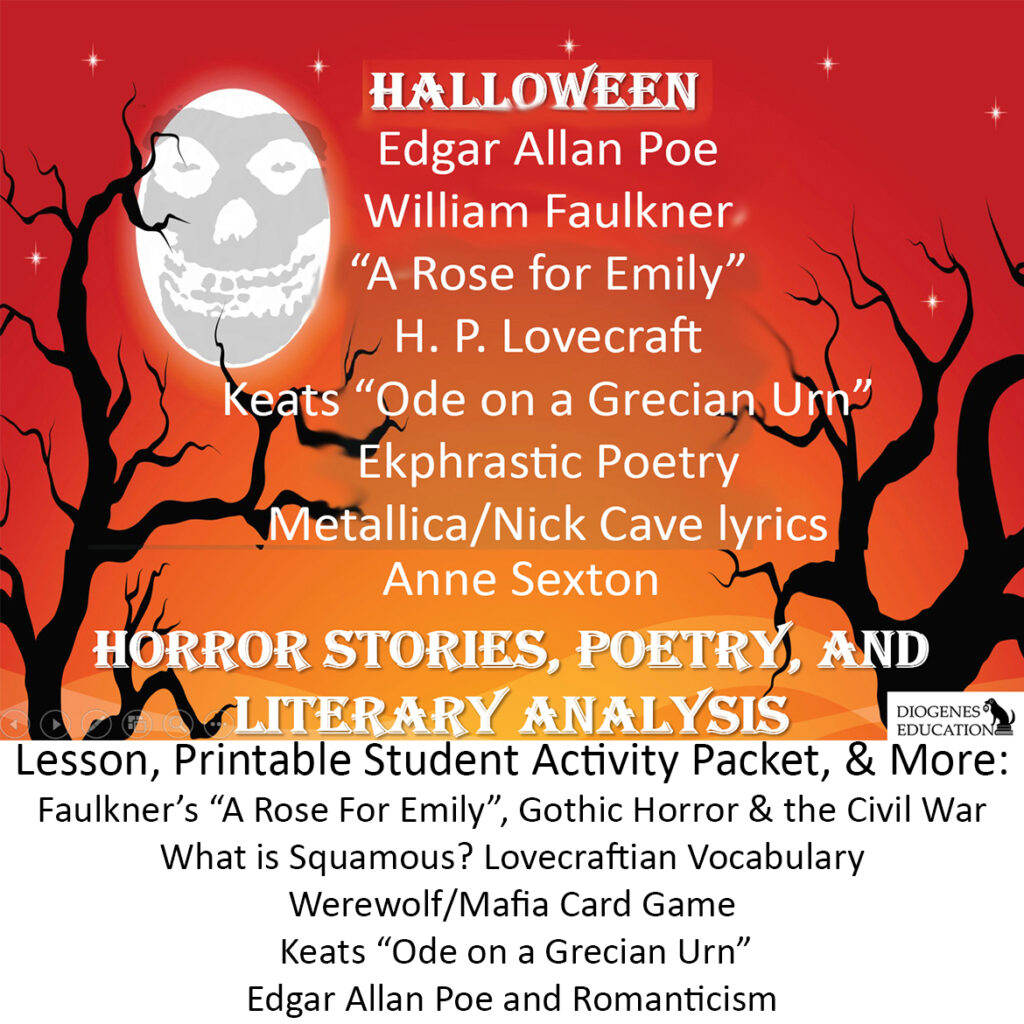
Halloween in High School
Halloween is here. Is your classroom ready? I’m not talking about spooky, scary skeletons and skulls decorating the room–this isn’t the primary years program. How can you make Halloween a fun and educational month for a high school English class? Horror stories can be a great tool for prose and poetry lessons. And while Edgar Allan Poe is always there for us, there is so much more to explore.
Metallica and H. P. Lovecraft in English Class

When does Metallica belong in the classroom? When you do a unit on H. P. Lovecraft. Explore how changing technology and secularism, along with discoveries of new continents and planets, led to a new type of horror. While this can also be explored in a New Historicism Unit, you can make it more English-focused with a Lovecraftian vocabulary unit (“What does Squamous mean?”), and compare the themes of terror in deep waters, cults, and ancient eldritch horrors in Lovecraft’s works to Metallica’s “The Thing That Should Not Be”. Lovecraft’s “Pickman’s Model” is short enough, with a jump-scare worthy ending, that it can be done in just one class.
Thematic Comparison: William Faulkner

The ending to William Faulkner’s “A Rose for Emily” still delivers a shock to students upon first read. It’s not just a macabre tale of gothic horror; it’s a great tool to teach how horror operates as a metaphor for the fears and anxieties of an era in this case: The post-Reconstruction-era south, and the dangers of clinging to the past. You can examine how Emily functions as a symbolic representation of the region through Faulkner’s diction, using words such as she was a “tradition” (with its connotation of systematic and cultural approval); then, compare and contrast it with Nick Cave and P. J. Harvey’s “Henry Lee”.
Eerie Ekphrastic Poetry

“Ode on a Grecian Urn” by Keats has been part of the poetry canon for decades. Anne Sexton’s “The Starry Night” is another poetic work that took artwork as its muse. Teach students that art is a dialogue: it comments on the world around it. Every poem and story could have been an essay had the creator wanted. When they see a work of art, what do they want to say in response? Have students choose a Halloween-themed artwork and write their own ekphrastic poem to practice their use of literary devices and figurative language.
Horror as a Metaphor

Every story has a deeper theme. Animal Farm is not only a story about animals, but it is also not only an allegory for the Soviet Union under Stalin: it’s about the dangers of any society becoming like it. Satire is always a mirror, even when the target is someone else. P. J. O’Rourke’s “The Ghosts of Responsibility” treats its ghostly subjects as a metaphor for nostalgia and regret in the same way Jordan Peele’s horror movies are metaphors of racial intolerance. Students can explore this topic, and then create their own scary tales that reflect the horrors of the world they see around them using metaphorical monsters.
Play Werewolf

After all the writing and analysis, there’s nothing wrong with celebrating with a little fun. Play a game of Werewolf (or Mafia…as it was known back in my day!) But you can still sneak in a little lesson: Require each person to give proof for why they think someone is a werewolf (logos) and why they don’t trust a player (ethos) as if it was a fun-focused debate… suddenly this game is a lesson in the tools of persuasive writing and rhetoric! Or host a Murder Mystery and teach a lesson in Essay Writing! And of course, as always, there’s Edgar Allan Poe.
Have a Spooky High School Halloween With These Lessons Below
Halloween: Edgar Allan Poe, Faulkner, Lovecraft, Keats Ekphrastic Poems Werewolf
Murder Mystery Detective Game Escape Room 2: The Case of the Weeping Widow
Get a FREE SAMPLE of our lessons at our online store


